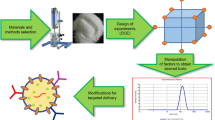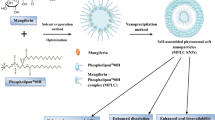Purpose
The thermodynamics and solid state properties of components and their interactions in a formulation for polymer-lipid hybrid nanoparticles (PLN) were characterized for screening lead lipid carriers and rational design of PLN.
Methods
Verapamil HCl (VRP) was chosen as a model drug and dextran sulfate sodium (DS) as a counter-ionic polymer. Solubility parameters of VRP, VRP-DS complex, and various lipids were calculated and partition of VRP and VRP-DS in lipids was determined. Thermodynamics of VRP binding to DS was determined by isothermal titration calorimetry (ITC). The solid state properties of individual components and their interactions were characterized using differential scanning calorimetry (DSC) and powder X-ray diffraction (PXRD).
Results
Dodecanoic acid (DA) was identified as the best lipid carrier among all lipids tested based on the solubility parameters and partition coefficients. VRP-DS complexation was a thermodynamically favorable process. Maximum binding capacity of DS and the highest drug loading capacity of DA were obtained at an equal ionic molar ratio of DS to VRP. In the PLN formulation, DA remained its crystal structure but had a slightly lower melting point, while VRP-DS complex was in an amorphous form.
Conclusions
Drug loading efficiency and capacity of a lipid matrix depend on the VRP-DS binding and the interactions of the complex with the lipid. A combined analysis of solubility parameters and partition coefficients is useful for screening lipid candidates for PLN preparation.







Similar content being viewed by others
Abbreviations
- DA:
-
dodecanoic acid
- DDI:
-
distilled and deionized
- DS:
-
dextran sulfate sodium salt
- DSC:
-
differential scanning calorimetry
- ITC:
-
isothermal titration calorimetry
- MP:
-
melting point
- PLN:
-
polymer-lipid hybrid nanoparticles
- PXRD:
-
powder X-ray diffraction
- SLN:
-
solid lipid nanoparticles
- VRP:
-
verapamil HCl
- VRP-DS complex:
-
the complex of verapamil HCl and dextran sulfate sodium salt
References
R. H. Müller, S. Maaßen, H. Weyhers, F. Specht, and J. S. Lucks. Cytotoxicity of magnetite loaded polylactide, polylactide/glycolide particles and solid lipid nanoparticles (SLN). Int. J. Pharm. 138:85–94 (1996).
C. Schwarz, W. Mehnert, J. S. Lucks, and R. H. Müller. Solid lipid nanoparticles (SLN) for controlled drug delivery. I. Production, characterization and sterilization. J. Control. Release 30:83–96 (1994).
R. H. Müller, W. Mehnert, J. S. Lucks, C. Schwarz, A. zur Muhlen, H. Weyhers, C. Freitas, and D. Ruhl. Solid lipid nanoparticles (SLN)–an alternative colloidal carrier system for controlled drug delivery. Eur. Pharm. Biopharm. 41:62–69 (1995).
S. A. Wissing, O. Kayser, and R. H. Müller. Solid lipid nanoparticles for parenteral drug delivery. Adv. Drug Deliv. Rev. 56:1257–1272 (2004).
W. Mehnert, and K. Mader. Solid lipid nanoparticles, production, characterization and applications. Adv. Drug Deliv. Rev. 47:165–196 (2001).
K. Westesen, H. Bunjes, and M. H. J. Koch. Physicochemical characterization of lipid nanoparticles and evaluation of their drug loading capacity and sustained release potential. J. Control. Release. 48:223–236 (1997).
V. Jenning, and S. Gohla. Comparison of wax and glyceride solid lipid nanoparticles (SLN). Int. J. Pharm. 196:219–222 (2000).
R. Cavalli, S. Morel, M. R. Gasco, P. Chetoni, and M. F. Saettone. Preparation and evaluation in vitro of colloidal lipospheres containing pilocarpine as ion pair. Int. J. Pharm. 117:243–246 (1995).
G. P. Zara, R. Cavalli, A. Fundaro, A. Bargoni, O. Caputo, and M. R. Gasco. Pharmacokinetics of doxorubicin incorporated in solid lipid nanoparticles (SLN). Pharm. Res. 40:281–286 (1999).
R. Cavalli, M. R. Gasco, P. Chetoni, S. Burgalassi, and F. M. Saettone. Solid lipid nanoparticles (SLN) as ocular delivery system for tobramycin. Int. J. Pharm. 238:241–245 (2002).
H. L. Wong, R. Bendayan, A. M. Rauth, and X. Y. Wu. Development of solid lipid nanoparticles containing ionically complexed chemometherapeutic drugs and chemosensitizers. J. Pharm. Sci. 93:1993–2008 (2004).
H. L. Wong, A. M. Rauth, R. Bendayan, and X. Y. Wu. A new solid lipid nanoparticle formulation increases cytotoxicity of doxorubicin against multidrug-resistant human breast cancer cells. Pharm. Res. In press.
H. L. Wong. Ph.D. dissertation, University of Toronto, Canada, 2006.
R. C. Rowe. Polar/nonpolar interactions in the granulation of organic substrates with polymer binding agents. Int. J. Pharm. 56:117–224 (1989).
D. J. Greenhalgh, A. C. Williams, P. Timmins, and P. York. Solubility parameters as predictors of miscibility in solid dispersions. J. Pharm. Sci. 88:1182–1190 (1999).
S. Schenderlein, M. Lück, and B. W. Müller. Partial solubility parameters of poly(d,l-lactide-co-glycolide). Int. J. Pharm. 286:19–26 (2004).
R. H. Müller, K. Mader, and S. Gohla. Solid lipid nanoparticles (SLN) for controlled drug delivery—a review of the state of art. Eur. J. Pharm. Biopharm. 50:161–177 (2000).
P. Bummer. Physical chemical considerations of lipid-based oral drug delivery-solid lipid nanoparticles. Crit. Rev. Therap. Drug Carr. Syst. 21:1–19 (2004).
P. Mura, A. Manderrioli, G. Bramanti, S. Furlanetto, and S. Pinzauti. Utilization of differential scanning calorimetry as a screening technique to determine the compatibility of ketoprofen with excipients. Int. J. Pharm. 119:71–79 (1995).
G. A. G. Novoa, J. Heinämäki, S. Mirza, O. Antikainen, A. I. Colarte, A. S. Paz, and J. Yliruusi. Physical solid-state properties and dissolution of sustained-release matrices of polyvinylacetate. Eur. J. Pharm. Biopharm. 59:343–350 (2005).
B. Hancock, P. York, and R. C. Rowe. The use of solubility parameters in pharmaceutical dosage form design. Int. J. Pharm. 148:1–21 (1997).
J. Barra, P. Bustamante, and E. Doelker. Use of the solubility parameter and surface energy concepts in the formulation of solid dosage forms. S.T.P. Pharm. Sci. 9:293–305 (1999).
J. L. Garson. The influence of polarity on the solubility parameter concept. J. Paint Technol. 38:43–57 (1966).
R. F. Fedors. A method for estimating both the solubility parameters and molar volumes of liquids. Polymer Engin. Sci. 14:147–154 (1974).
D. W. Van Krevelen. Cohesive properties and solubility. In D.V. Van Krevelen. (ed.), Properties of Polymers: Their Correlation with Chemical Structure; Their Numerical Estimation and Prediction from Additive Group Contribution. Elsevier, New York, 1990, pp. 189–224.
I. Jelesarov, and H. R. Bosshard. Isothermal titration calorimetry and differential scanning calorimetry as complementary tools to investigate the energetics of biomolecular recognition. J. Mol. Recognit. 12:3–18 (1999).
C. M. Hansen. The three dimensional solubility parameters—key to paint component affinities. 1. Solvents, plasticizers, polymers and resins. J. Paint Technol. 39:104–117 (1967).
R. C. Rowe. Interactions of lubricants with microcrystalline cellulose and anhydrous lactose—a solubility parameter approach. Int. J. Pharm. 41:223–226 (1988).
G. Puglisi, N. A. Santagati, R. Pignatello, C. Ventura, F. A. Bottino, S. Mangiafico, and G. Mazzone. Inclusion complexation of 4-biphenylacetic acid with β-cyclodextrin. Drug Dev. Ind. Pharm. 16:395–413 (1990).
F. Han, N. Taulier, and T. V. Chalikian. Association of the minor groove binding drug Hoechst 33258 with d(CGCGAATTCGCG)2: volumetric, calorimetric, and spectroscopic characterizations. Biochem. 44:9785–9794 (2005).
A. zur Mühlen, C. Schwarz, and W. Mehnert. Solid lipid nanoparticles (SLN) for controlled drug delivery—drug release and release mechanism. Eur. J. Pharm. Biopharm. 45:149–155 (1998).
C. Freitas and R. H. Müller. Correlation between long-term stability of solid lipid nanoparticles (SLN™) and crystallinity of the lipid phase. Eur. J. Pharm. Biopharm. 47:125–132 (1999).
Acknowledgments
This work was supported by the Canadian Institute of Health Research. The authors would like to thank Dr. Sr. Petrov, Department of Chemistry, University of Toronto, for his comments on the PXRD patterns; Dr. T.V. Chalikian and Dr. Lakshmi P. Kotra for kind permission on use of ITC and a freeze drier, respectively. In addition, the discussion with Ho-lun Wong about SLN, Jubo Liu about solubility parameters and Ms. Feixue Han for help with ITC data fitting; the kind donations of free samples from Gattefossé Inc. (Canada), and the Ontario Graduate Scholarship in Science and Technology (OGSST) to Y. Li are also gratefully acknowledged.
Author information
Authors and Affiliations
Corresponding author
Rights and permissions
About this article
Cite this article
Li, Y., Taulier, N., Rauth, A.M. et al. Screening of Lipid Carriers and Characterization of Drug-Polymer-Lipid Interactions for the Rational Design of Polymer-Lipid Hybrid Nanoparticles (PLN). Pharm Res 23, 1877–1887 (2006). https://doi.org/10.1007/s11095-006-9033-2
Received:
Accepted:
Published:
Issue Date:
DOI: https://doi.org/10.1007/s11095-006-9033-2




